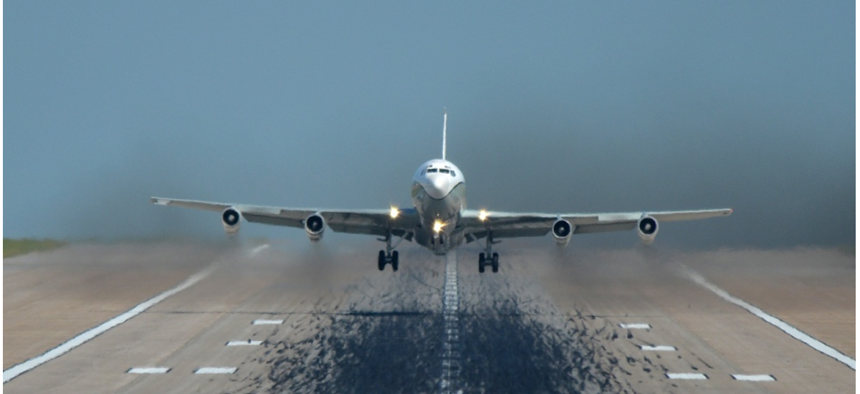
An OC-135B Open Skies aircraft takes flight on Aug. 13, at Offutt AFB, Neb. Joshua Plueger
Don’t Enshrine A Russian Advantage In Surveillance Flights Over the US
Provisions in the House version of the 2018 National Defense Authorization Act would prevent the Pentagon from matching Russia’s advances in aerial photography.
The Treaty on Open Skies was one of the earliest proposals to bring stability and security to the era of the nuclear arms race. Unfortunately, certain provisions in the current House version of the 2018 National Defense Authorization Act, if passed, would severely disadvantage the U.S. Defense Department and skew the Treaty considerably in favor of Russia.
An agreement to permit aerial reconnaissance flights by the United States and Soviet Union over each other’s territory was first proposed during one of the darkest periods of East-West conflict. In 1955, neither side knew much about each other’s nuclear weapons — only that each was developing forces capable of destroying the other. Both sides therefore planned for worst-case scenarios, immeasurably increasing the risk of nuclear war. So at the first East-West summit conference, President Dwight D. Eisenhower proposed aerial reconnaissance flights by the U.S. and USSR over each other’s territory. The Soviets firmly rejected the notion, calling it a likely pretext for espionage.
So the idea lay dormant until the tail end of the Cold War, when it was revived by President George H.W. Bush and hammered out by NATO and Warsaw Pact negotiators. In 1992, the Open Skies Treaty was signed by 27 states, and it went into effect in 2002. Eight more countries have since joined the Treaty, raising the number of parties to 35.
The Soviet Union and Warsaw Pact have long since passed into history, but the Treaty continues to be a valuable instrument for security and stability for European and North American states. Under its terms, any member can overfly any territory of another; such observation may be restricted for flight safety, but not for reasons of national security. Each party has a yearly quota of overflights and must receive an equal quota of overflights each year; to date, treaty parties have flown some 800 flights. A copy of the information collected is made available to the host party and any Treaty party may access it. The transparency afforded by the Treaty is vital to member states’ national security and strategic stability.
But in recent years, Russia has upgraded the technology it uses on overflights, while U.S. equipment has remained largely the same. In March 2016, U.S. Strategic Command warned that Russia was “ahead of us” in technology used on Open Skies observation flights. Three months later, the U.S. Defense Department approved a Russian request to use modernized sensors and, in April of this year, Russia put its new gear to use in an observation flight over the U.S.
Shockingly, legislation now under consideration by Congress would bar the U.S. from improving its own Open Skies aircraft. Last month, the House Armed Services Committee passed a version of the 2018 National Defense Authorization Act that would prohibit the United States from upgrading the sensors on its observation flights. The bill would also prohibit the U.S. from conducting any surveillance flights under the Treaty unless a plan for the entire year is submitted to Congress in advance.
Such provisions would needlessly grant a unilateral advantage to Russia. What could possibly justify Congressional action to bar our Defense Department from improving its own imagery as permitted by the Treaty? Further, the United States has a quota of 42 Treaty overflights per year and is obligated to accept the same number over its territory. The U.S. should be able to use its quota efficiently and not be hobbled by the kind of unnecessary bureaucratic obstacles that these provisions would place before it.
The Open Skies Treaty is very popular with America’s allies, even in the face of recent Russian compliance issues. Despite this, some in Congress have continually sought to undermine the agreement. Still, the Senate Armed Services Committee appears to have rejected these provisions; hopefully, that opposition will stand as the bill moves through the Senate. The final Defense Authorization bill should allow the United States to continue implementing Open Skies to our advantage, granting the U.S. Defense Department the use of all the tools available under the Treaty.
NEXT STORY: A Mercenary-Led Surge Won’t Solve Afghanistan



